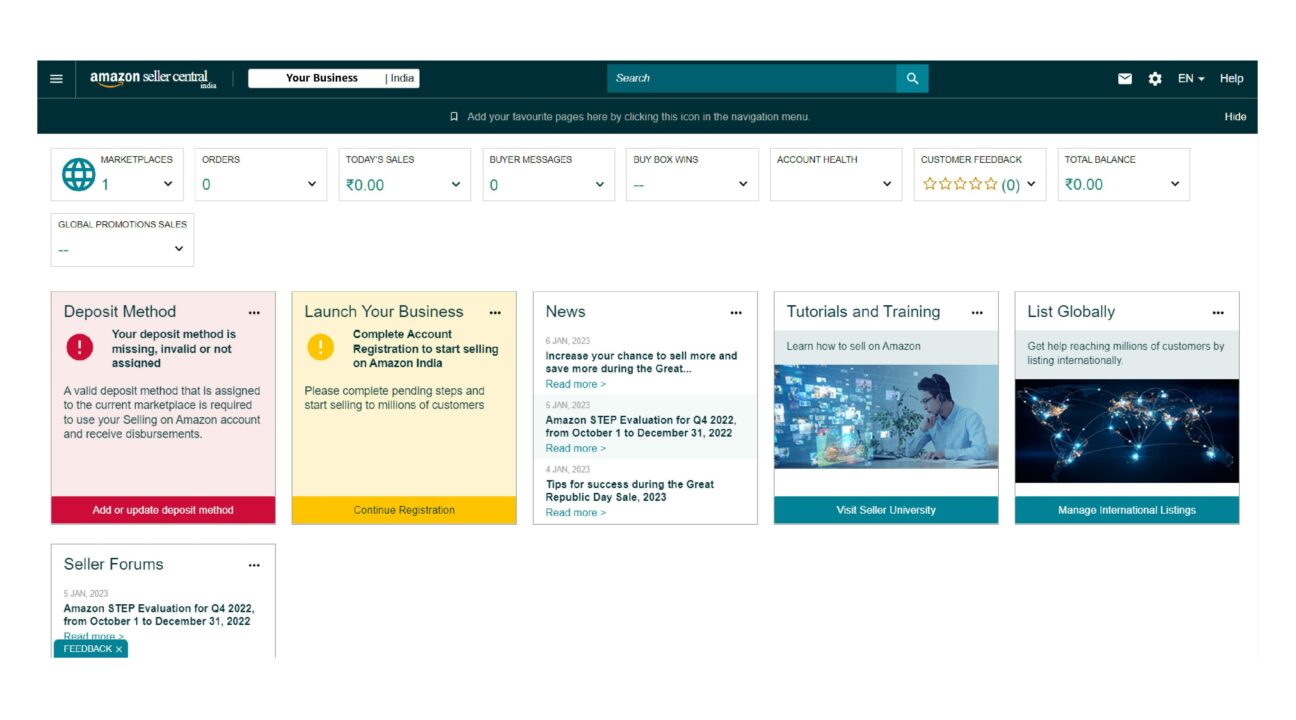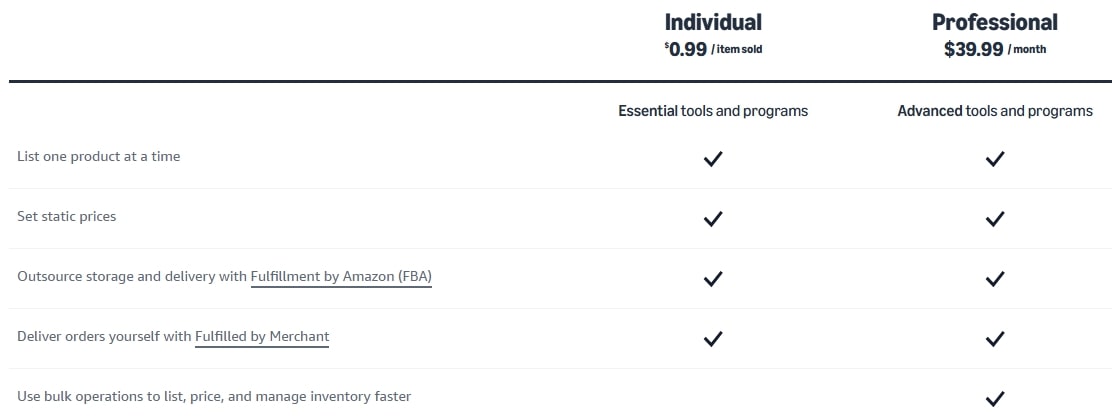Drive sales on autopilot with ecommerce-focused features
See FeaturesEvery new entrepreneur eventually faces the Shopify vs. Amazon dilemma. After all, both platforms give you the tools to sell online and reach a global audience, but they do it in very different ways.
Shopify offers you total freedom to build your unique brand identity and own the customer experience. However, you’ll need to handle most of the marketing yourself and grow the audience base from scratch.
Amazon, on the other hand, helps you reach millions of shoppers but limits your ability to build a distinct brand identity.
In this guide, we’ll compare Shopify vs. Amazon for sellers, breaking down the pros, cons, and best use cases for each to help you make the smartest choice.
Shopify vs. Amazon: Key differences at a glance
Understanding the distinct features of Shopify and Amazon enables you to market and scale your brand in various ways. However, the final choice ultimately depends on your goals, budget, and the level of control you need over your business. Here’s a brief comparison of Shopify vs Amazon:
| Feature | Shopify | Amazon |
| Platform type | Ecommerce website builder | Online marketplace |
| Ownership | You fully own your website, data, and brand | Amazon controls the platform and customer experience |
| Branding | Full control over your brand design and store’s look | Limited branding as products appear under Amazon’s ecosystem |
| Traffic source | You generate your own traffic through marketing and SEO | Amazon provides built-in traffic from its large customer base |
| Fees | Monthly subscription + transaction fees | Seller fees + commissions on each sale |
| Customer data | Full access to customer data and insights | Limited access to customer data, as Amazon owns the customer relationship |
| Scalability | Highly scalable | Limited scalability |
| Best for | Entrepreneurs who want complete independence and a direct customer line | Sellers who want faster exposure and traffic |
What is Shopify and how does it work?
Shopify is a leading ecommerce platform that lets you build, customize, and run your online store without requiring major technical skills.
Here’s how Shopify’s model works:
- Build your store: Shopify provides a user-friendly website builder that allows you to launch a functional and professional online storefront that reflects your brand identity
- Customize your design: Use Shopify’s drag-and-drop editor to adjust layouts, colors, fonts, and themes, and create your brand’s unique look and feel
- Manage everything in one place: From product listings to inventory, payments, and discounts, Shopify provides an easy-to-use dashboard that helps you run your business efficiently
- Integrate marketing tools: Shopify connects seamlessly with the best email marketing platforms, allowing you to automate your email and SMS marketing campaigns to nurture your customers and recover abandoned carts
Omnisend is an ecommerce marketing platform that’s powerful without being clunky. Its ability to integrate smoothly with Shopify makes it popular among beginners and professionals. It lets you sync your customer data, segment audiences, and run automated email marketing and SMS campaigns directly from your Shopify store.
Shopify’s pricing plans are flexible for various stages of growth. The Basic plan starts at $39/month for new sellers, and high-tiered plans, such as Shopify, Advanced, and Plus packages, are well-suited for scaling businesses and come with additional features.
Here’s what a Shopify dashboard looks like:

Kerrits success story:
“Using Omnisend with Shopify completely changed how we connect with our customers. Automating our email and SMS campaigns allowed us to communicate consistently without overwhelming our small marketing team. We’ve been able to send highly targeted messages, from welcome emails to abandoned cart reminders, using real customer data. These automations save us time, drive repeat purchases, and increase ROI.”
Sara Florin, Senior Director of Branding & Marketing at Kerrits
With Omnisend’s Shopify integration, Kerrits increased revenue-per-email for marketing emails by 50%, with 23% of all orders coming from automated emails.
Read the full case study.
What is Amazon, and how does it work?
Amazon is one of the world’s largest global online marketplaces where millions of shoppers search for, compare, and buy products daily. Unlike Shopify, where you build your own store, Amazon allows you to list and sell your products alongside other sellers within its ecosystem.
Since the platform already has a massive audience and ever-growing traffic, all you need to do is list your products and wait for shoppers to discover and purchase them.
Here’s how Amazon’s model works:
- Account setup: You create a seller account and list your products alongside other sellers in the same category, while Amazon handles product discovery, payment processing, and buyer relationships
- Fulfillment options: There are two main options you can choose from:
- FBA (Fulfilled by Amazon): Amazon stores, packs, and ships your products directly to customers
- FBM (Fulfilled by Merchant): You manage your own inventory, packaging, and shipping
- Buyer behavior: Most shoppers prioritize quick, reliable purchases over specific brands, making Amazon ideal for quick sales but less effective for building long-term customer relationships
Here’s what the Amazon seller central dashboard looks like:

When comparing Shopify vs. Amazon, keep in mind that Amazon provides instant exposure to a massive audience, but limits access to customer data and communication.
That’s why many small business owners use Amazon for product exposure and Shopify for long-term customer retention. By integrating Shopify with Amazon, you create a powerful hybrid ecommerce strategy that combines the strengths of both platforms.
Shopify vs. Amazon: Pros and cons
For an honest Amazon vs. Shopify comparison, you need to understand what each platform excels at and where it falls short. This will help you make an informed decision that aligns with your specific business goals.
Shopify pros and cons
Pros
- Complete brand control and customization: Unlike Amazon, Shopify lets you design and customize every part of your online store, from layout to logo. It gives you creative freedom to build a unique brand identity, and if you know some advanced tech, you can take your store design up a notch.
- Direct customer ownership and data: When you start a Shopify store, you get full access to customer data and contact information. This helps you build an email list, connect with your customers, and send personalized marketing campaigns that win customer trust and loyalty over time.
- Scalable for all business sizes: For beginners starting a Shopify store or those growing an established one, Shopify offers flexible plans and enterprise-level solutions. You can gradually upgrade to features and apps to scale based on your business requirements.
Cons
- Needs effective marketing: Unlike Amazon, Shopify doesn’t have regular traffic of shoppers. So, you’re responsible for generating traffic for your Shopify store through organic and paid marketing strategies, such as SEO and paid advertising, which requires time and effort.
- Fulfillment responsibility: Unless you integrate your store with a third-party logistics provider or use the Shopify Fulfillment Network, you’re responsible for storing, packing, and shipping orders yourself. This can be overwhelming and time-consuming.
Amazon pros and cons
Pros
- Massive customer base: Amazon gives you immediate exposure to millions of active shoppers who visit with high purchase intent. This traffic eliminates the challenge of driving visitors to your website, making it easier to gain product visibility and drive early sales.
- Established credibility and trust: Most buyers already trust Amazon because it has built credibility over time. Customers may be more comfortable buying from a new or unknown seller on Amazon than from a brand-new, independent website.
- Convenient fulfillment options: The FBA service handles warehousing, picking, packing, shipping, and customer service for your orders. This hands-off fulfillment saves you time, ensures fast delivery, and allows you to focus solely on sourcing products and marketing.
Cons
- Restricted branding and customer control: Amazon controls the look and layout of your listings, making it hard to differentiate your brand from competitors. Plus, Amazon owns the customer data, limiting you from direct customer communication.
- High competition: You’ll be constantly competing with other sellers on Amazon who often drive prices down. This can force you into price wars that further reduce your profit margins.
Shopify vs. Amazon: Fees and pricing
As you compare Shopify vs. Amazon, pricing should be a key determining factor in your final decision. Shopify works on a subscription model with additional transaction and app costs, while Amazon takes a commission-based approach.
Let’s take a closer look at Shopify vs. Amazon fees:
Shopify
Subscription plans:
- Basic: $39/month
- Shopify: $105/month
- Advanced: $399/month
- Plus: $2,300/month

Transaction fees:
- Shopify Payments: Standard credit card processing fees ( 2.9% + $0.30/transaction)
- Third-Party Payment Gateways: 0.5%–2% additional fee depending on your plan
App/Theme costs: Optional apps and premium themes can range from free to $300+, depending on your needs.
For most sellers, Shopify fees are predictable monthly expenses, but if you rely on paid apps or third-party gateways, your costs can rise as your store grows.
For instance, if you sell a product for $100, use Shopify Payments, and your payment processing fee is 2.9% + 30¢, your total fee is $3.20, leaving you with $96.80 profit before product costs.
Amazon
Selling plans:
- Individual plan: $0.99/ item sold
- Professional plan: $39.99/month

Referral fees (commission): Amazon takes a percentage of each sale, typically 8–45%, depending on your product category
Fulfillment by Amazon (FBA) fees: Costs vary by product size, weight, and storage time in Amazon’s warehouses
Amazon’s fees vary by product type and sales volume, so your profits will fluctuate with each sale.
For example, if you sell a $100 product on Amazon with a 15% referral fee and $5 FBA fee, you’ll pay $20 total in fees, leaving you with $80 profit before product costs.
Can you use Amazon and Shopify together?
The simple answer is yes. You can leverage both Amazon and Shopify to increase visibility and sales.
The smartest approach isn’t always choosing one over the other. Instead, combining them can help you reach more customers and grow your brand faster.
This strategy is called multichannel selling, where you list and sell your products on multiple platforms simultaneously.
It allows you to:
- List Amazon products on your Shopify store: The top Shopify store owners import their Amazon listings into Shopify so that customers can also buy directly from their websites
- Sell Shopify products on Amazon: You can sync your Shopify inventory with Amazon, so your products appear in Amazon’s marketplace without double-managing stock or pricing
- Manage everything in one place: Shopify’s dashboard lets you track orders, inventory, and sales performance across both platforms, saving time and reducing errors
Combining your Amazon store vs. Shopify presence gives you the best of both worlds. You can leverage Amazon for product visibility and Shopify for customer retention and brand growth.
Shopify vs. Amazon: Which should you choose?
So, is it better to sell on Amazon or Shopify? The reality is that both platforms excel in different areas. Choosing between selling on Shopify vs. Amazon ultimately depends on your expertise in store management and how much control you want over your business.
Here’s how to decide based on your situation:
- Beginners on a budget: If you’re just getting started and want to test product demand without investing in marketing or website development, Amazon is the better option
- Long-term brand builders: If your goal is to create a recognizable, scalable brand and own your customer relationships, Shopify is a clear winner
- Established sellers: The smartest strategy for experienced sellers is to use Amazon for product visibility and Shopify to nurture and retain customers
“At Omnisend, we always tell merchants that owning your audience is the key to long-lasting growth. Amazon gives you reach, but Shopify gives you relationships, and that’s where real, repeatable success happens.”
Paulius Milisauskas
VP of Customer Operations, Omnisend
Shopify vs. Amazon: FAQs
1. Can I sell on both Shopify and Amazon at the same time?
Yes. You can integrate your Shopify store with Amazon to sell on both platforms and manage listings, inventory, orders, and fulfillment from one dashboard.
2. Which is more profitable: Amazon or Shopify?
Shopify can be more profitable than Amazon long-term, since you control pricing and customer data, while on Amazon, profits depend on fees and competition.
3. Is Shopify or Amazon better for beginners?
Amazon is better for beginners due to its ready-made audience and simple setup, while Shopify requires more marketing and brand-building effort.
4. What’s the main difference between Shopify and Amazon?
Shopify lets you build and own your branded store, while Amazon is a marketplace where you list products under its platform and reach existing shoppers.
TABLE OF CONTENTS
TABLE OF CONTENTS


No fluff, no spam, no corporate filler. Just a friendly letter, twice a month.

 OFFER
OFFER







